I am, of course, paraphrasing the famous 'A Hitchhiker's Guide to the Galaxy' book title, which I believe is perfect for our topic today. Our journey has many intergalactic stops in the universe of preserving what’s in season this summer: leaves, petals, fruit and flowers. Much like in the book (and movie), you will discover the same prolific inventiveness that we use here to capture the essence of summer in a jar. The journey can move fast, much like when you have to bring the fruit to a brisk boil, or it can progress slowly, reminiscent of making Romanian magiun by slow cooking over an open fire or in the residual heat of bread ovens.
This intergalactic journey also speaks of itinerant recipes. These are the recipes we carry with us when we leave home, those we jot down on a napkin during an accidental conversation with a stranger, and those given to us as tokens of love or souvenirs. The pace and ritual of preparing these recipes transport me to a world free of doubt. I appreciate the safety in the number of stages I need to follow and the knowledge of what lies ahead: after the fruit, sugar and lemon comes the setting point, a muslin cloth, a sterilised jar, a ladle, a funnel, a lid, a label, and so on.
These are the recipes I took with me when I moved to the UK: rose petal jam (I even planted three roses in my garden especially for jam), plum jam and sour cherry confiture.
Fortunately, when I moved to the UK, I found an entire universe of jams, marmalades, and jellies in a league of their own. I was introduced to fruit curds, which I hadn’t heard of before. I discovered a kindred spirit in the British folks, who love their orange marmalade and strawberry jam and are particular about the perfectly set jelly, really proving their knowledge about the delicate precision of the process. Plus, there’s an abundance of advice waiting to be explored in books! That’s how I came across the wonderful Pam Corbin, known as Pam the Jam on social media. She’s a lovely and generous person, and she holds the title of the UK’s leading expert in jam making. In my eyes, Pam is also the Queen of Low Sugar Jams, but I’ll share more about that later.
Before we begin, I want you to know that you don’t need your own garden, allotment or fruit orchard to make these recipes. A farmers’ market, a good supermarket or online supplier, and even a little foraged hedgerow fruit or some rose petals from a wild rose you found while walking the dog, will be enough to make a little bit of jam or jelly.
Also, there is nothing wrong with frozen fruit, especially if you know it comes straight from the farm. One example is the British Frozen Fruit company in the South Herefordshire countryside, which I have used on various occasions. I also use supermarket frozen fruit, because the freezing process in itself seems to preserve more nutritional value of the fruit compared to the complex procedures and sprays used to keep produce “fresh”. Freezing fruit is often done when the fruit is ripe (so not ripening while in transit or in storage) and frozen immediately after picking.
With all this being said, let’s explore the galaxy of Romanian fruit preserves.
Magiun
This is a very thick fruit butter, now exclusively associated with plums. When we say "magiun," we mean "magiun de prune," which can be plums or damsons. In the past, when sugar was expensive, magiun would be cooked and reduced until the water evaporated, concentrating the fruit's natural sugars so much that it could be safely stored for years. Traditionally, there were two stages: first, the fruit was cooked in large iron kettles hanging over an open fire until it turned into a thick paste, known as plum butter. Then the plum butter was transferred into earthenware pots and placed in a bread oven after the loaves had been baked, when the temperature was low. The aim was to dry the top layer of the jam enough to seal the contents beneath.
I will tell the whole story of magiun in a separate post, so make sure you follow me (it’s free) so you don’t miss it.
In the meantime, there are two recipes for magiun in two of my books: “Carpathia’ and ‘Tava’.
For a quick plum magiun, here is a shortcut:
When I don’t have time to make plum butter from scratch, or the season isn’t right but I still want to bake a traditional cake, I use prunes (dried plums) to blend into a paste. Here is the recipe:
In a food processor, blend 300 g pitted prunes with the zest and juice of 2 medium lemons and 1 tablespoon of water or (better) rum or kirsch.
Use it in this Linzer tart with cocoa pastry, or in a moreish shortbread cake where you can add a few grapes on top. If you make apricot jam with dried apricots (follow the recipe above), use it to create a cake called Garbo. Garbo, or Gerbeaud, is a layered cake filled with apricot jam and walnuts, where all the layers are baked together in the same tray. The cake is glazed with melted chocolate before serving. Or, use the plum butter to top Hungarian langoși—these delicious fried flatbreads that are usually spread with sour cream and typically cheese, but we have a sweet version with jam.

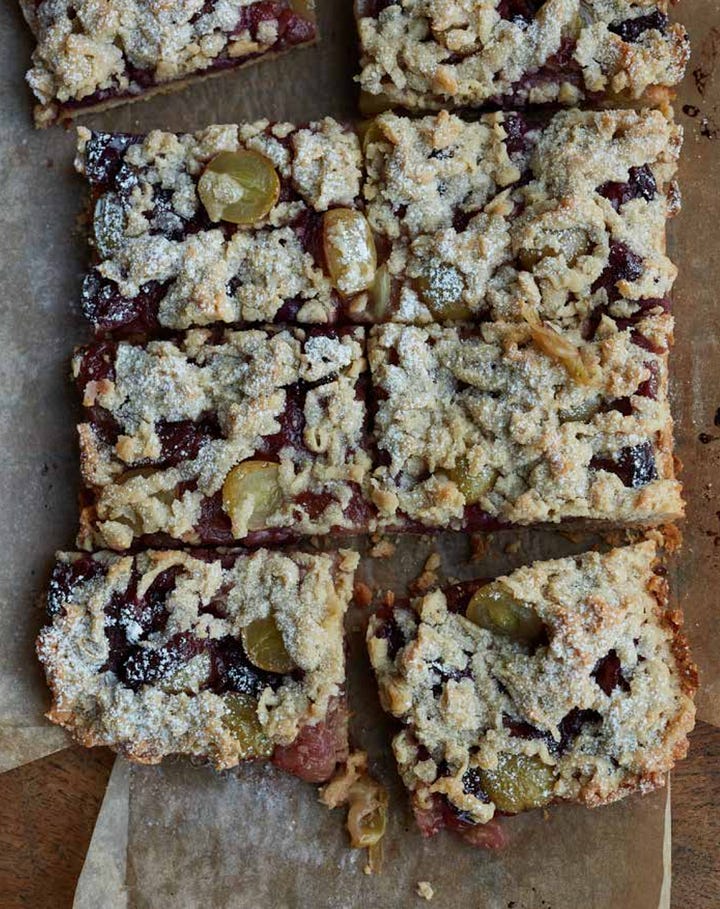


As you can see from the few examples above, jams are used extensively in Romanian baking. A thousand recipes contain the phrase ‘spread some jam’ on almost every biscuit or layer of cake. But we do have another type of fruit preserve: confiture, known as dulceață.
Jam Vs Confiture
To make a long story short: jam is when you cook the fruit and sugar together from the beginning, allowing it to reach the desired consistency. In Romania, we love jams with curd cheese dumplings, which are a childhood favourite for many and a delightful treat to return home to after school or work.
A confiture is when you first set the water and sugar to make a thick syrup (usually jam point or a little higher, toward soft ball on a sugar thermometer) and then add the fruit to the syrup. In this way, the fruit will remain more or less intact.
The most popular confiture in Romania is made with sour cherries, called vișine. Dulceață de vișine is sharp, sweet and the fruit is gooey, almost candied in the syrup. I often use them instead of glacé cherries, which are made with food colouring and other stuff.
I love this sour cherry confiture served with Romanian papanași: curd cheese doughnuts. Something you need to try when you visit Romania
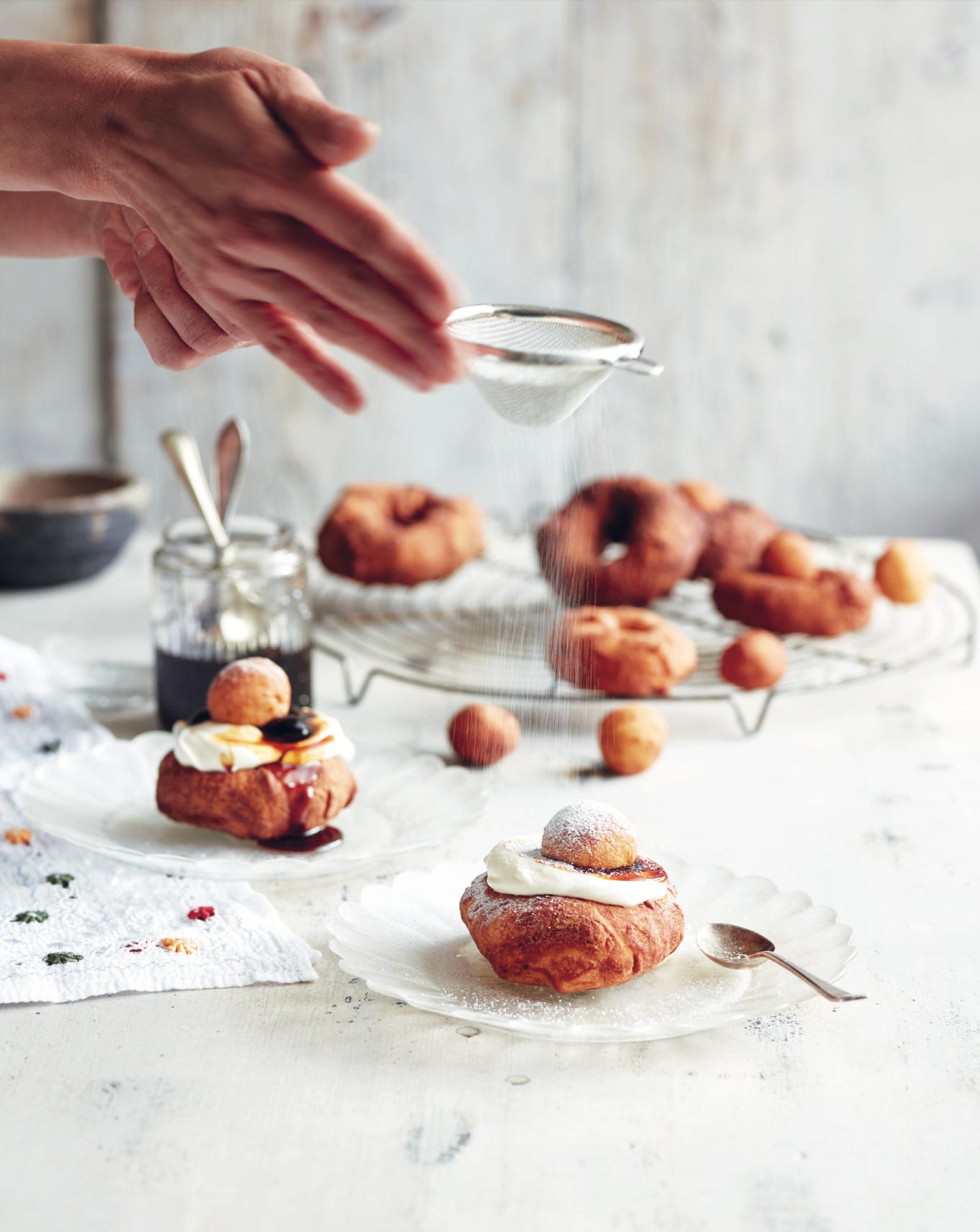
However, a real delicacy is the rose petal confiture, called dulceață de trandafiri, where the rose petals are kept in syrup inside the jar. It’s wonderful as a filling in these buttery crescents.
Rose-Petal Confiture, Dulceață de trandafiri
Makes 1 x 100 ml jar or just enough to serve on the day you make it, spooned over slices of strawberries.
Ingredients:
100 g rose petals
4 tablespoons of lemon juice (from fresh lemons)
200 ml water
150 g caster sugar
Method:
Pick the rose petals from a rose that has an intense pink colour and a strong scent. Any rose will work: pink dogrose or any other wild rose, Damascus rose, red rose or any rose with the qualities mentioned above.
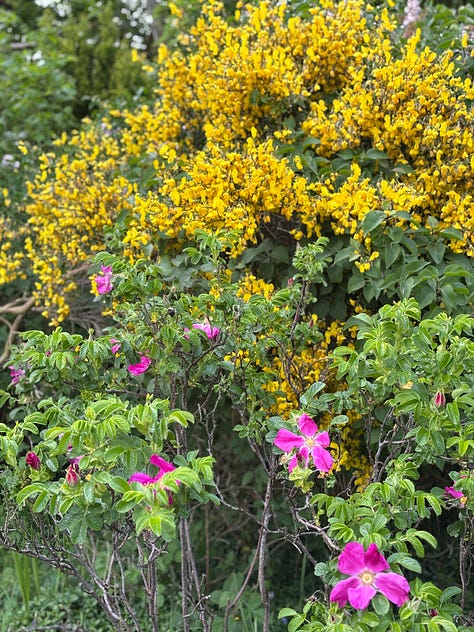
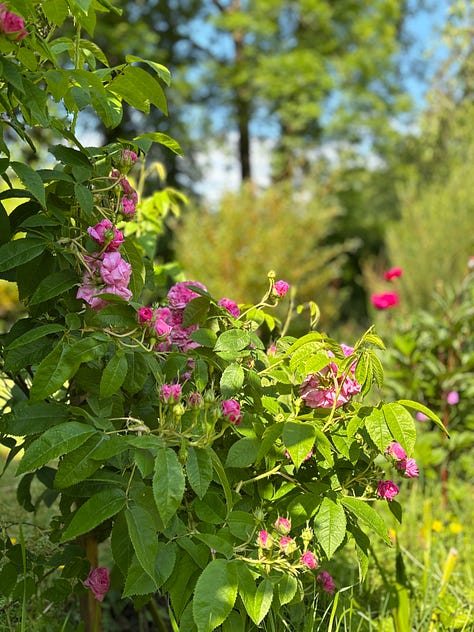

In a bowl, rub the rose petals with the lemon juice, crushing them lightly with your fingertips. Set aside.
Bring the water and sugar to the boil in a pan, then simmer until it reaches the consistency of very thin honey. (On a sugar thermometer, this is the jam consistency.) Add the rose petals and simmer until the mixture thickens again. Allow it to cool and serve on the same day. It can be kept in the fridge for one week. Otherwise, you should pour the jam into a sterilised jar while still hot.
Rose Petal Jelly
However, in recent years, I’ve fallen into the habit of making rose petal jelly. I can’t tell you how wonderful it is to spoon over fresh fruit or shortbread cookies or even serve it with cheese in the autumn and winter months. It really brings back the scent of summer and wild roses.
If I happen to have some elderflowers or blackcurrant leaves or fruit, I add them to the petals for a light hint of a different flavour. There is a pink elderflower near my house and only a few clusters of its flowers add a more intense colour to the jelly.
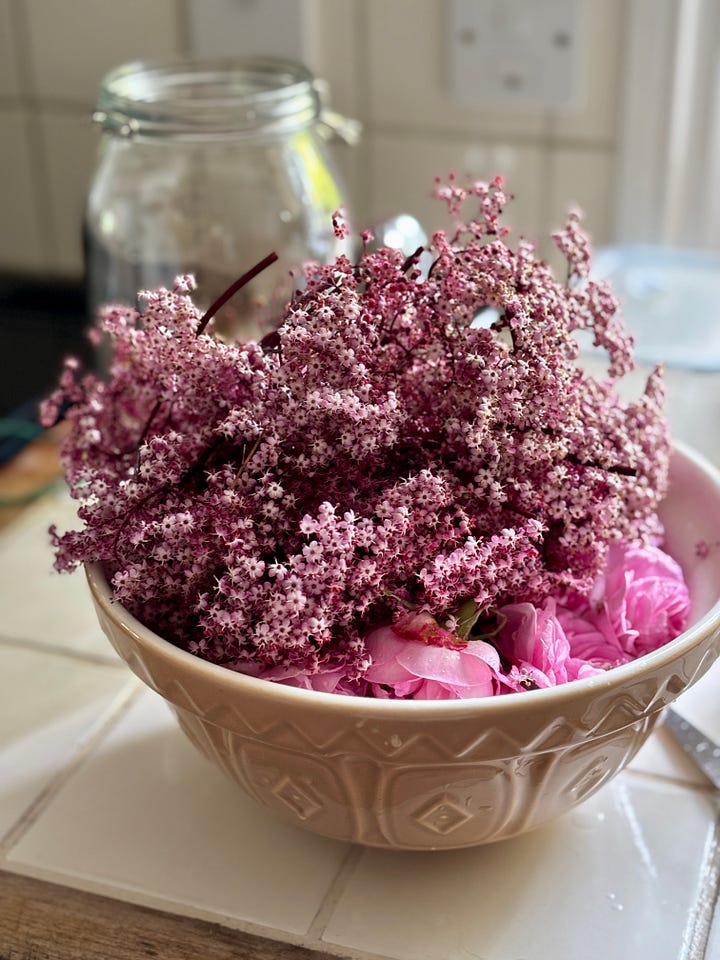

The recipe I use is by Pam Corbin, the Queen of Jam Making in the UK, a River Cottage extraordinaire and the expert whom Hugh Fearnley-Whittingstall always seeks advice from. Pam also bakes and has a baking book filled with delightful British cakes.
One of her books, ‘The Book of Preserves’, (link here) features a whole chapter on low-sugar jams that will truly open your eyes to new possibilities. You’ll learn a lot about the role of sugar, pectin, and acid, and how you can use them in the right quantities to make low-sugar jams that are safe to eat.
For the rose petal jelly, I have been using one of her recipes, where the quantity of sugar is not overpowering. With Pam’s approval, I’m sharing it here.
Ingredients:
Makes 5x100g jars
600g cooking apples
2 red eating apples (for the colour of their skin)
½ lemon, roughly chopped into small pieces
Splash of white wine vinegar or white wine
1 litre water
200g (or more) very fragrant, unsprayed rose petals (deep pink or red if possible)
400g granulated or preserving sugar
1–2 tsp rosewater (optional)
Method:
There’s no need to peel or core the apples – just rinse then chop them into 2–3cm pieces; this can be done quickly by pulsing them in a food processor. Put the apples in a roomy pan with the lemon, vinegar and measured water. Cover and bring to a simmer for 10 minutes or so, then add the rose petals, squashing with a spoon or jam skimmer to make sure they are below the water. Continue to simmer the mixture, covered, for another 20 minutes, or until the apples have broken down to a soft pulp and some of the dye has been extracted from the rose petals and any red apple skins.
Strain the cooked mixture through a scalded jelly bag set over a large bowl, or double-strain it using a fine sieve. Leave to drip through for several hours or overnight, as necessary.
My notes here are that you can find advice on double straining on Pam’s Instagram. Link here.
When the time is nearly up, sterilise your jars and twist-on lids. Chill a couple of saucers or spoons, ready to test for setting point. Pour the apple stock into a measuring jug, discarding any sediment that may have settled at the bottom of the bowl; you should have 750ml stock. Pour into a large heavy-based or preserving pan and bring to a brisk boil for 2–3 minutes. Reduce the heat and sprinkle in the sugar a third at a time, stirring each time until it has dissolved. Then increase the heat to a brisk boil for 8–10 minutes until setting point is reached. Remove from the heat and stir in the rosewater, if using. Rest the jelly for a minute or two. If a skin has formed, remove it with a slotted spoon or jam skimmer. Tip the jelly into a wide-necked jug with a good pouring lip, then fill the sterilised jars to the brim and seal immediately. Invert the jars for a minute or so, to ensure the lids are sterilised, then turn the right way up.
Store in a cool, dry, dark place for up to a year. Keep in the fridge once opened and use within 3–4 months.
Variation LAVENDER JELLY Replace the roses with 25–50g lavender flower heads – the quantity will vary according to the strength of fragrance of the variety. Variation ELDERFLOWER JELLY Replace the roses with 15 elderflower heads and the apples with gooseberries or a mixture of apples and gooseberries.
One last thing in the list of all things sweet: Romanian Șerbet
Șerbet in Romania is a type of fruit fondant. It is made by bringing sugar and fruit juice to a soft ball consistency, then beating or whisking it while cooling until it turns opaque, resembling creamed honey. The most famous variety is raspberry șerbet, but any fruit can be used. Something else we do when no fruit is in season, is to use water and sugar and different flavourings such as coffee or cocoa powder. Șerbet is typically served by scooping a small quantity with a teaspoon and placing the teaspoon in a glass of cold water. Next to the glass, there is a cup of Turkish coffee. You then remove the teaspoon from the glass and eat the softened șerbet, followed by a sip of coffee and a swig of water, which the fondant has flavoured. Just to give you an example of how popular șerbet still is in Romania, look at this offer from the artisan makers ‘Moara Veche’. This is a screenshot of their website, where you can find not only fruit șerbet but also coffee, mint, honey and cinnamon, and even rose petal.
We have reached the end of this fantastic journey into the world of jams and jellies and many other delicacies. As always, please like the posts by clicking on the ‘heart’, and subscribe (it’s free) to the newsletter to learn more about this part of Eastern Europe. Plus, new culinary tours will be announced soon. Stay in touch.










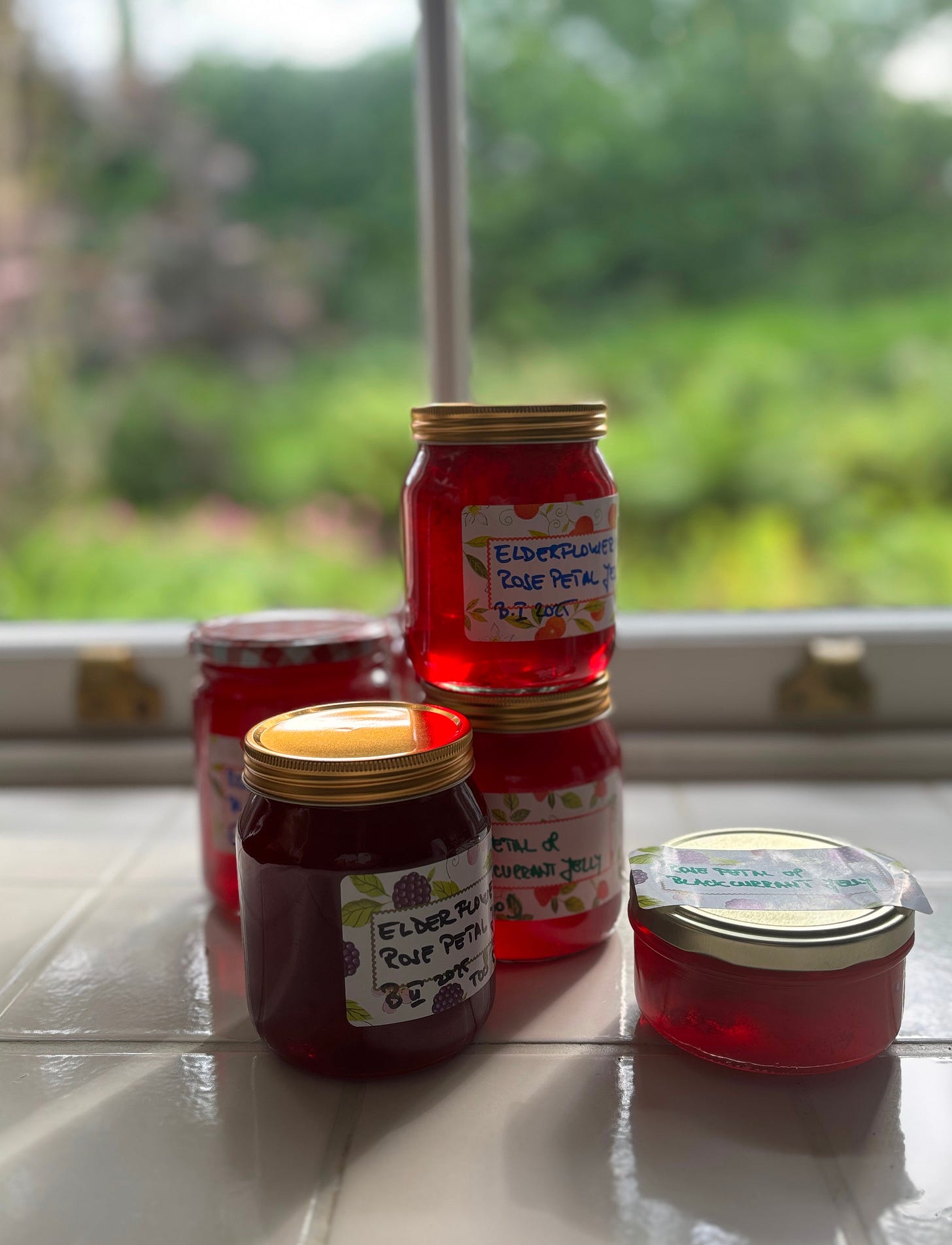
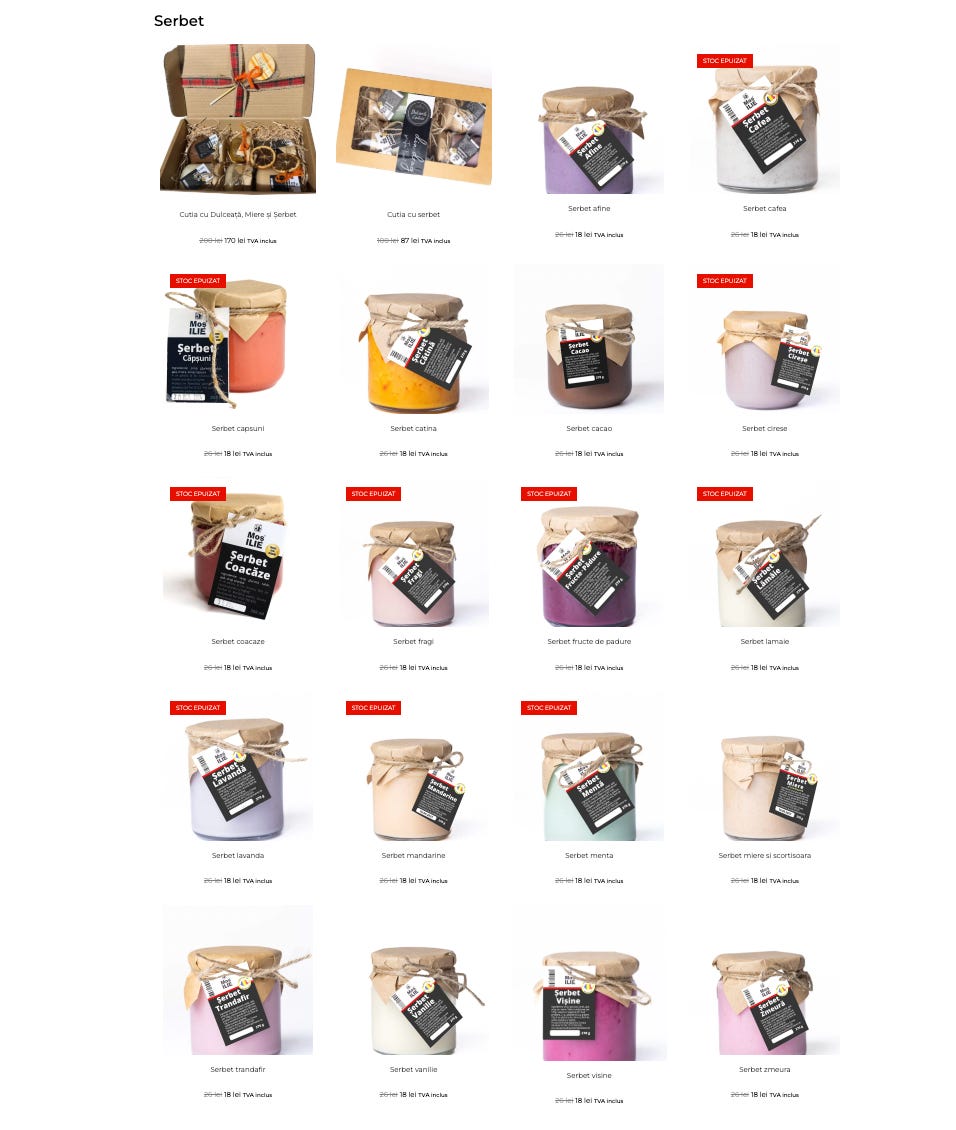
I loved that intergalactic journey, grazie Irina